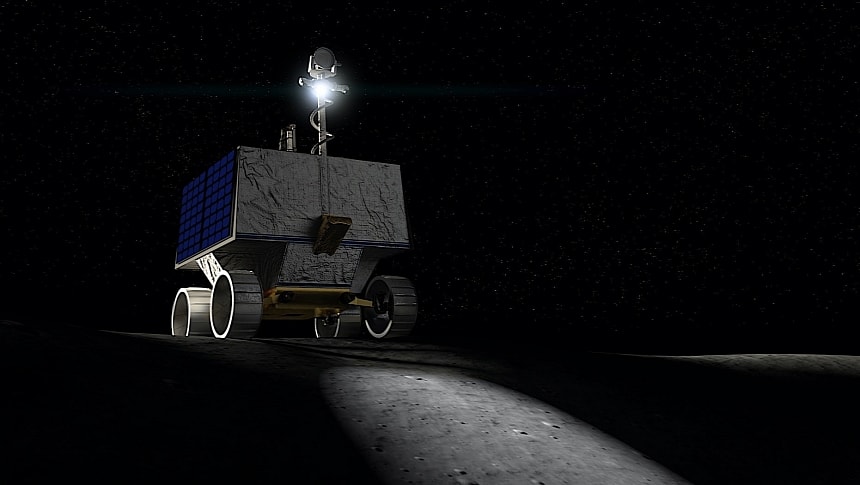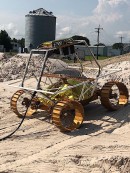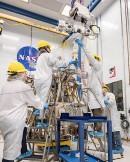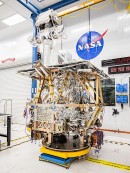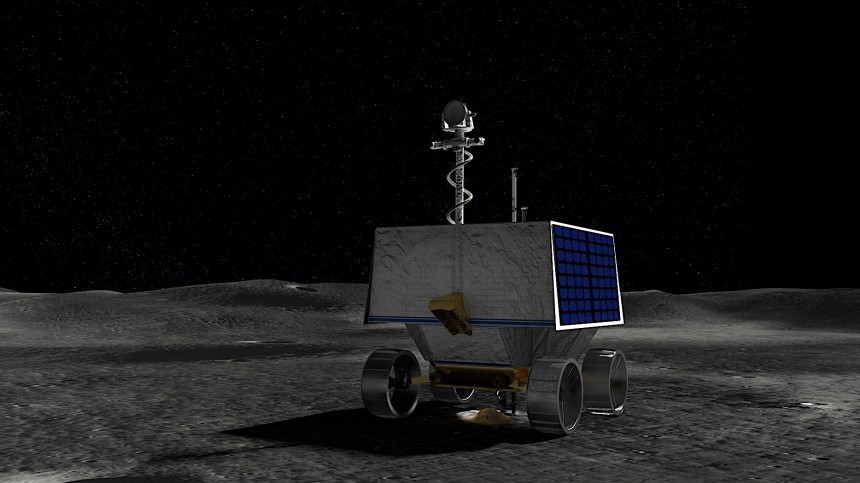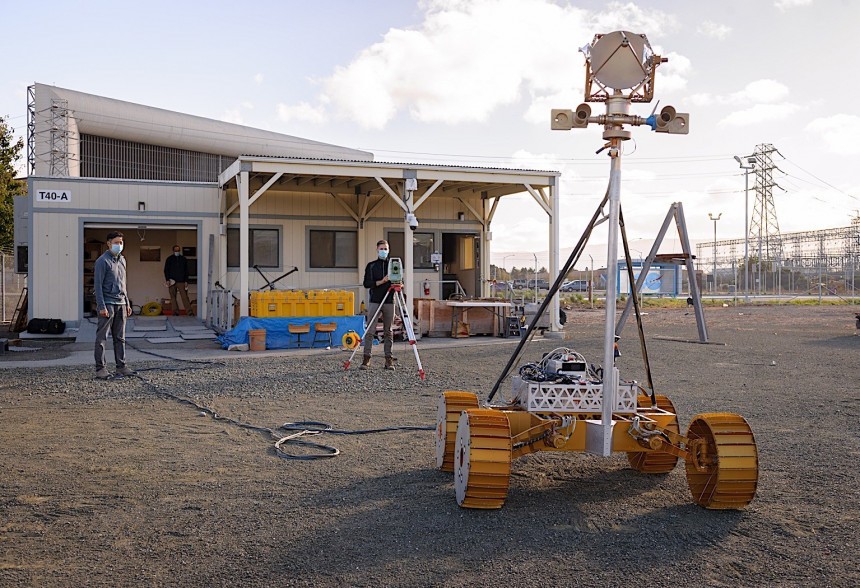If all goes according to plan, American space agency NASA will launch at the end of the year its very first uncrewed rover meant for the exploration of the Moon. They call it VIPER, and for all intents and purposes, it will also be the world's first planetary rover to be equipped with headlights. But believe it or not, none of these two things are what brought us here now.
VIPER stands for Volatiles Investigating Polar Exploration Rover, and from that name its purpose is obvious: look for water ice in the South Pole region of the Moon, the same place where the astronauts of the Artemis program will land and the location where, hopefully, humanity's first lunar settlement will be established.
We talked about the VIPER at length a while back, highlighting its main attributes. The thing is about the same size as a golf cart, more or less a cube 5 feet by 5 feet by 8 feet (1.5 meters by 1.5 meters by 2.5 meters). It weighs 992 pounds (450 kilograms) and it is powered by a solar-charged battery capable of 450 watts peak power.
NASA's planetary rovers usually have a lot of wheels, but the VIPER will rely on only four of them. It will, however, be able to drive itself sideways or diagonally; it will be able to spin in a circle and even move in any direction without changing the way it is facing. In extreme situations, the rover will be capable of moving each of its wheels independently in a sort of weird, mechanical walk.
The main instrument of the rover is a 3.28-foot (1-meter) drill. VIPER will use it to dig into the Moon's surface and collect samples for analysis. The science instruments on board will help it determine the distribution, physical state and composition of ice deposits on Luna.
That's great and all, but the rover will land in one of the most hostile places on the Moon. On top of that, it will also venture into permanently shadowed craters, where it's very cold and very dark (headlights, remember?). So, how will this thing see where it is and what it's doing?
You see, the headlights I mentioned earlier, in the form of a couple of blue LEDs, will not be placed like on terrestrial vehicles, to either side of the rover's front end, but high up on a mast. The same mast will also hold a suite of instruments that will help it with navigation, inspection, and drilling.
NASA likens this mast and the instruments on it to the rover's head and neck. At its highest, the mast stands eight feet (2.5 meters) above the wheel rims and is equipped with a pair of stereo navigation cameras. For communication purposes, a low- and high-gain antenna is also installed on this pole.
It is the cameras that will form the eyes of the rover. They are installed on a part of the mast that gimbals, and that gives the rover the ability to pan as much as 400 degrees in either direction and tilt up and down as much as 75 degrees.
The camera's height from the ground gives the rover a human-like perspective, and that could prove invaluable for the science to be conducted up there. There are plans to have the VIPER record sweeping panoramas of the lunar surface, as well as detailed shots of rocks and craters as small as four inches (ten cm) in diameter. And the rover will be capable of doing that from a distance of 50 feet (15 meters).
The images of the lunar surfaces will be captured with the help of the headlights, which will work pretty much the same way the ones of your car do, casting a narrow, long-distance beam. Access to light will also allow the rover's operators here on Earth to see obstacles or points of interest.
The other piece of hardware present on the rover's mast, the high-gain antenna, is gimballed too and precision-pointed to allow it to keep its orientation toward Earth, even when the rover is driving.
All this talk about the rover's mast is here for a reason. The thing just got installed on the VIPER and was raised for the first time, after being subjected to a number of tests. The moment marks an important step in the development of the rover.
The VIPER will depart our planet at the end of the year onboard a SpaceX Falcon Heavy rocket and installed on a lander called Peregrine. It will fly to the Moon as part of a private mission handled by space company Astrobotic as part of NASA's Commercial Lunar Payload Services (CLPS).
If Astrobotic sounds familiar that's because at the beginning of the year it was responsible for the first-ever launch of the CLPS program, the botched Peregrine lander.
We talked about the VIPER at length a while back, highlighting its main attributes. The thing is about the same size as a golf cart, more or less a cube 5 feet by 5 feet by 8 feet (1.5 meters by 1.5 meters by 2.5 meters). It weighs 992 pounds (450 kilograms) and it is powered by a solar-charged battery capable of 450 watts peak power.
NASA's planetary rovers usually have a lot of wheels, but the VIPER will rely on only four of them. It will, however, be able to drive itself sideways or diagonally; it will be able to spin in a circle and even move in any direction without changing the way it is facing. In extreme situations, the rover will be capable of moving each of its wheels independently in a sort of weird, mechanical walk.
The main instrument of the rover is a 3.28-foot (1-meter) drill. VIPER will use it to dig into the Moon's surface and collect samples for analysis. The science instruments on board will help it determine the distribution, physical state and composition of ice deposits on Luna.
That's great and all, but the rover will land in one of the most hostile places on the Moon. On top of that, it will also venture into permanently shadowed craters, where it's very cold and very dark (headlights, remember?). So, how will this thing see where it is and what it's doing?
NASA likens this mast and the instruments on it to the rover's head and neck. At its highest, the mast stands eight feet (2.5 meters) above the wheel rims and is equipped with a pair of stereo navigation cameras. For communication purposes, a low- and high-gain antenna is also installed on this pole.
It is the cameras that will form the eyes of the rover. They are installed on a part of the mast that gimbals, and that gives the rover the ability to pan as much as 400 degrees in either direction and tilt up and down as much as 75 degrees.
The camera's height from the ground gives the rover a human-like perspective, and that could prove invaluable for the science to be conducted up there. There are plans to have the VIPER record sweeping panoramas of the lunar surface, as well as detailed shots of rocks and craters as small as four inches (ten cm) in diameter. And the rover will be capable of doing that from a distance of 50 feet (15 meters).
The images of the lunar surfaces will be captured with the help of the headlights, which will work pretty much the same way the ones of your car do, casting a narrow, long-distance beam. Access to light will also allow the rover's operators here on Earth to see obstacles or points of interest.
All this talk about the rover's mast is here for a reason. The thing just got installed on the VIPER and was raised for the first time, after being subjected to a number of tests. The moment marks an important step in the development of the rover.
The VIPER will depart our planet at the end of the year onboard a SpaceX Falcon Heavy rocket and installed on a lander called Peregrine. It will fly to the Moon as part of a private mission handled by space company Astrobotic as part of NASA's Commercial Lunar Payload Services (CLPS).
If Astrobotic sounds familiar that's because at the beginning of the year it was responsible for the first-ever launch of the CLPS program, the botched Peregrine lander.
